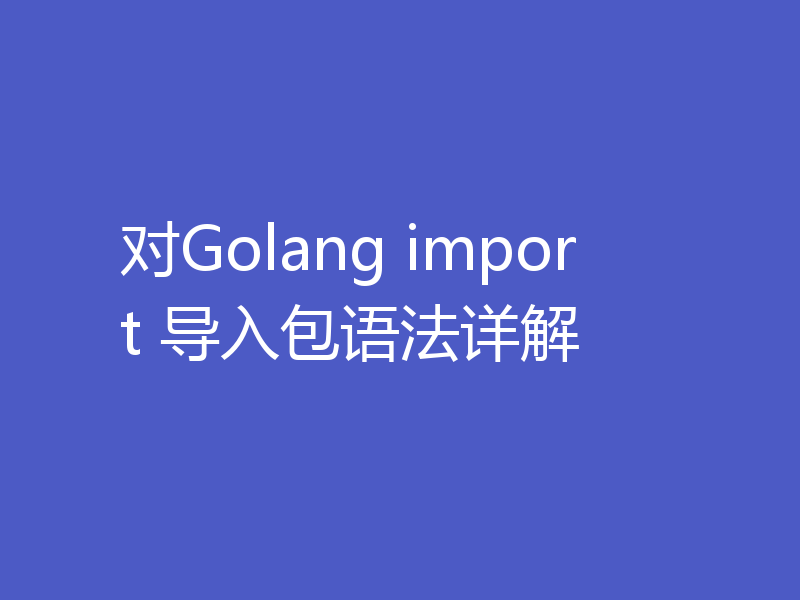Go html/template 模板的使用实例详解
怎么入门Golang编程?需要学习哪些知识点?这是新手们刚接触编程时常见的问题;下面golang学习网就来给大家整理分享一些知识点,希望能够给初学者一些帮助。本篇文章就来介绍《Go html/template 模板的使用实例详解》,涉及到html模板、template模板,有需要的可以收藏一下
从字符串载入模板
我们可以定义模板字符串,然后载入并解析渲染:
template.New(tplName string).Parse(tpl string)
// 从字符串模板构建
tplStr := `
{{ .Name }} {{ .Age }}
`
// if parse failed Must will render a panic error
tpl := template.Must(template.New("tplName").Parse(tplStr))
tpl.Execute(os.Stdout, map[string]interface{}{Name: "big_cat", Age: 29})
从文件载入模板
模板语法
模板文件,建议为每个模板文件显式的定义模板名称: {{ define "tplName" }} ,否则会因模板对象名与模板名不一致,无法解析(条件分支很多,不如按一种标准写法实现),另展示一些基本的模板语法。
- 使用 {{ define "tplName" }} 定义模板名
- 使用 {{ template "tplName" . }} 引入其他模板
- 使用 . 访问当前数据域:比如 range 里使用 . 访问的其实是循环项的数据域
- 使用 $. 访问绝对顶层数据域
views/header.html
{{ define "header" }}
<meta charset="UTF-8"><meta name="viewport" content="width=device-width, user-scalable=no, initial-scale=1.0, maximum-scale=1.0, minimum-scale=1.0"><meta http-equiv="X-UA-Compatible" content="ie=edge"><title>{{ .PageTitle }}</title>
{{ end }}
views/footer.html
{{ define "footer" }}
{{ end }}
views/index/index.html
{{ define "index/index" }}
{{/*引用其他模板 注意后面的 . */}}
{{ template "header" . }}
<div>
hello, {{ .Name }}, age {{ .Age }}
</div>
{{ template "footer" . }}
{{ end }}
views/news/index.html
{{ define "news/index" }}
{{ template "header" . }}
{{/* 页面变量定义 */}}
{{ $pageTitle := "news title" }}
{{ $pageTitleLen := len $pageTitle }}
{{/* 长度 > 4 才输出 eq ne gt lt ge le */}}
{{ if gt $pageTitleLen 4 }}
<h4>{{ $pageTitle }}</h4>
{{ end }}
{{ $c1 := gt 4 3}}
{{ $c2 := lt 2 3 }}
{{/*and or not 条件必须为标量值 不能是逻辑表达式 如果需要逻辑表达式请先求值*/}}
{{ if and $c1 $c2 }}
<h4>1 == 1 3 > 2 4
{{ end }}
<div>
<ul>
{{ range .List }}
{{ $title := .Title }}
{{/* .Title 上下文变量调用 func param1 param2 方法/函数调用 $.根节点变量调用 */}}
<li>{{ $title }} -- {{ .CreatedAt.Format "2006-01-02 15:04:05" }} -- Author {{ $.Author }}</li>
{{end}}
</ul>
{{/* !empty Total 才输出*/}}
{{ with .Total }}
<div>总数:{{ . }}</div>
{{ end }}
</div>
{{ template "footer" . }}
{{ end }}
</h4>
template.ParseFiles
手动定义需要载入的模板文件,解析后制定需要渲染的模板名 news/index 。
// 从模板文件构建
tpl := template.Must(
template.ParseFiles(
"views/index/index.html",
"views/news/index.html",
"views/header.html",
"views/footer.html",
),
)
// render template with tplName index
_ = tpl.ExecuteTemplate(
os.Stdout,
"index/index",
map[string]interface{}{
PageTitle: "首页",
Name: "big_cat",
Age: 29,
},
)
// render template with tplName index
_ = tpl.ExecuteTemplate(
os.Stdout,
"news/index",
map[string]interface{}{
"PageTitle": "新闻",
"List": []struct {
Title string
CreatedAt time.Time
}{
{Title: "this is golang views/template example", CreatedAt: time.Now()},
{Title: "to be honest, i don't very like this raw engine", CreatedAt: time.Now()},
},
"Total": 1,
"Author": "big_cat",
},
)
template.ParseGlob
手动的指定每一个模板文件,在一些场景下难免难以满足需求,我们可以使用通配符正则匹配载入。
1、正则不应包含文件夹,否则会因文件夹被作为视图载入无法解析而报错
2、可以设定多个模式串,如下我们载入了一级目录和二级目录的视图文件
// 从模板文件构建
tpl := template.Must(template.ParseGlob("views/*.html"))
template.Must(tpl.ParseGlob("views/*/*.html"))
// render template with tplName index
// render template with tplName index
_ = tpl.ExecuteTemplate(
os.Stdout,
"index/index",
map[string]interface{}{
PageTitle: "首页",
Name: "big_cat",
Age: 29,
},
)
// render template with tplName index
_ = tpl.ExecuteTemplate(
os.Stdout,
"news/index",
map[string]interface{}{
"PageTitle": "新闻",
"List": []struct {
Title string
CreatedAt time.Time
}{
{Title: "this is golang views/template example", CreatedAt: time.Now()},
{Title: "to be honest, i don't very like this raw engine", CreatedAt: time.Now()},
},
"Total": 1,
"Author": "big_cat",
},
)
Web服务器
结合模板库和 Gin 实现一个可以使用模板渲染并返回 html 页面的 web 服务。
package main
import (
"html/template"
"log"
"net/http"
"time"
)
var (
htmlTplEngine *template.Template
htmlTplEngineErr error
)
func init() {
// 初始化模板引擎 并加载各层级的模板文件
// 注意 views/* 不会对子目录递归处理 且会将子目录匹配 作为模板处理造成解析错误
// 若存在与模板文件同级的子目录时 应指定模板文件扩展名来防止目录被作为模板文件处理
// 然后通过 view/*/*.html 来加载 view 下的各子目录中的模板文件
htmlTplEngine = template.New("htmlTplEngine")
// 模板根目录下的模板文件 一些公共文件
_, htmlTplEngineErr = htmlTplEngine.ParseGlob("views/*.html")
if nil != htmlTplEngineErr {
log.Panic(htmlTplEngineErr.Error())
}
// 其他子目录下的模板文件
_, htmlTplEngineErr = htmlTplEngine.ParseGlob("views/*/*.html")
if nil != htmlTplEngineErr {
log.Panic(htmlTplEngineErr.Error())
}
}
// index
func IndexHandler(w http.ResponseWriter, r *http.Request) {
_ = htmlTplEngine.ExecuteTemplate(
w,
"index/index",
map[string]interface{}{"PageTitle": "首页", "Name": "sqrt_cat", "Age": 25},
)
}
// news
func NewsHandler(w http.ResponseWriter, r *http.Request) {
_ = htmlTplEngine.ExecuteTemplate(
w,
"news/index",
map[string]interface{}{
"PageTitle": "新闻",
"List": []struct {
Title string
CreatedAt time.Time
}{
{Title: "this is golang views/template example", CreatedAt: time.Now()},
{Title: "to be honest, i don't very like this raw engine", CreatedAt: time.Now()},
},
"Total": 1,
"Author": "big_cat",
},
)
}
func main() {
http.HandleFunc("/", IndexHandler)
http.HandleFunc("/index", IndexHandler)
http.HandleFunc("/news", NewsHandler)
serverErr := http.ListenAndServe(":8085", nil)
if nil != serverErr {
log.Panic(serverErr.Error())
}
}
注意 :模板对象是有名字属性的, template.New("tplName") ,如果没有显示的定义名字,则会使用第一个被载入的视图文件的 baseName 做默认名,比如我们使用 template.ParseFiles/template.ParseGlob 直接生成模板对象时,没有指定模板对象名,则会使用第一个被载入的文件,比如 views/index/index.html 的 baseName 即 index.html 做默认名,而后如果 tplObj.Execute 方法执行渲染时,会去查找名为 index.html 的模板,所以常用的还是 tplObj.ExecuteTemplate 自己指定要渲染的模板名,省的一团乱。
以上就是《Go html/template 模板的使用实例详解》的详细内容,更多关于golang的资料请关注golang学习网公众号!
 对Golang import 导入包语法详解
对Golang import 导入包语法详解
- 上一篇
- 对Golang import 导入包语法详解

- 下一篇
- go流程控制代码详解
-

- Golang · Go教程 | 4小时前 | 格式化输出 printf fmt库 格式化动词 Stringer接口
- Golangfmt库用法与格式化技巧解析
- 140浏览 收藏
-

- Golang · Go教程 | 4小时前 |
- Golang配置Protobuf安装教程
- 147浏览 收藏
-

- Golang · Go教程 | 4小时前 |
- Golang中介者模式实现与通信解耦技巧
- 378浏览 收藏
-

- Golang · Go教程 | 4小时前 |
- Golang多协程通信技巧分享
- 255浏览 收藏
-

- Golang · Go教程 | 5小时前 |
- Golang如何判断变量类型?
- 393浏览 收藏
-

- Golang · Go教程 | 5小时前 |
- Golang云原生微服务实战教程
- 310浏览 收藏
-

- Golang · Go教程 | 5小时前 |
- Golang迭代器与懒加载结合应用
- 110浏览 收藏
-

- Golang · Go教程 | 6小时前 | 性能优化 并发安全 Golangslicemap 预设容量 指针拷贝
- Golangslicemap优化技巧分享
- 412浏览 收藏
-

- Golang · Go教程 | 6小时前 |
- Golang代理模式与访问控制实现解析
- 423浏览 收藏
-

- Golang · Go教程 | 6小时前 |
- Golang事件管理模块实现教程
- 274浏览 收藏
-

- 前端进阶之JavaScript设计模式
- 设计模式是开发人员在软件开发过程中面临一般问题时的解决方案,代表了最佳的实践。本课程的主打内容包括JS常见设计模式以及具体应用场景,打造一站式知识长龙服务,适合有JS基础的同学学习。
- 543次学习
-

- GO语言核心编程课程
- 本课程采用真实案例,全面具体可落地,从理论到实践,一步一步将GO核心编程技术、编程思想、底层实现融会贯通,使学习者贴近时代脉搏,做IT互联网时代的弄潮儿。
- 516次学习
-

- 简单聊聊mysql8与网络通信
- 如有问题加微信:Le-studyg;在课程中,我们将首先介绍MySQL8的新特性,包括性能优化、安全增强、新数据类型等,帮助学生快速熟悉MySQL8的最新功能。接着,我们将深入解析MySQL的网络通信机制,包括协议、连接管理、数据传输等,让
- 500次学习
-

- JavaScript正则表达式基础与实战
- 在任何一门编程语言中,正则表达式,都是一项重要的知识,它提供了高效的字符串匹配与捕获机制,可以极大的简化程序设计。
- 487次学习
-

- 从零制作响应式网站—Grid布局
- 本系列教程将展示从零制作一个假想的网络科技公司官网,分为导航,轮播,关于我们,成功案例,服务流程,团队介绍,数据部分,公司动态,底部信息等内容区块。网站整体采用CSSGrid布局,支持响应式,有流畅过渡和展现动画。
- 485次学习
-

- ChatExcel酷表
- ChatExcel酷表是由北京大学团队打造的Excel聊天机器人,用自然语言操控表格,简化数据处理,告别繁琐操作,提升工作效率!适用于学生、上班族及政府人员。
- 3164次使用
-

- Any绘本
- 探索Any绘本(anypicturebook.com/zh),一款开源免费的AI绘本创作工具,基于Google Gemini与Flux AI模型,让您轻松创作个性化绘本。适用于家庭、教育、创作等多种场景,零门槛,高自由度,技术透明,本地可控。
- 3376次使用
-

- 可赞AI
- 可赞AI,AI驱动的办公可视化智能工具,助您轻松实现文本与可视化元素高效转化。无论是智能文档生成、多格式文本解析,还是一键生成专业图表、脑图、知识卡片,可赞AI都能让信息处理更清晰高效。覆盖数据汇报、会议纪要、内容营销等全场景,大幅提升办公效率,降低专业门槛,是您提升工作效率的得力助手。
- 3405次使用
-

- 星月写作
- 星月写作是国内首款聚焦中文网络小说创作的AI辅助工具,解决网文作者从构思到变现的全流程痛点。AI扫榜、专属模板、全链路适配,助力新人快速上手,资深作者效率倍增。
- 4509次使用
-

- MagicLight
- MagicLight.ai是全球首款叙事驱动型AI动画视频创作平台,专注于解决从故事想法到完整动画的全流程痛点。它通过自研AI模型,保障角色、风格、场景高度一致性,让零动画经验者也能高效产出专业级叙事内容。广泛适用于独立创作者、动画工作室、教育机构及企业营销,助您轻松实现创意落地与商业化。
- 3785次使用
-
- Golangmap实践及实现原理解析
- 2022-12-28 505浏览
-
- go和golang的区别解析:帮你选择合适的编程语言
- 2023-12-29 503浏览
-
- 试了下Golang实现try catch的方法
- 2022-12-27 502浏览
-
- 如何在go语言中实现高并发的服务器架构
- 2023-08-27 502浏览
-
- 提升工作效率的Go语言项目开发经验分享
- 2023-11-03 502浏览





